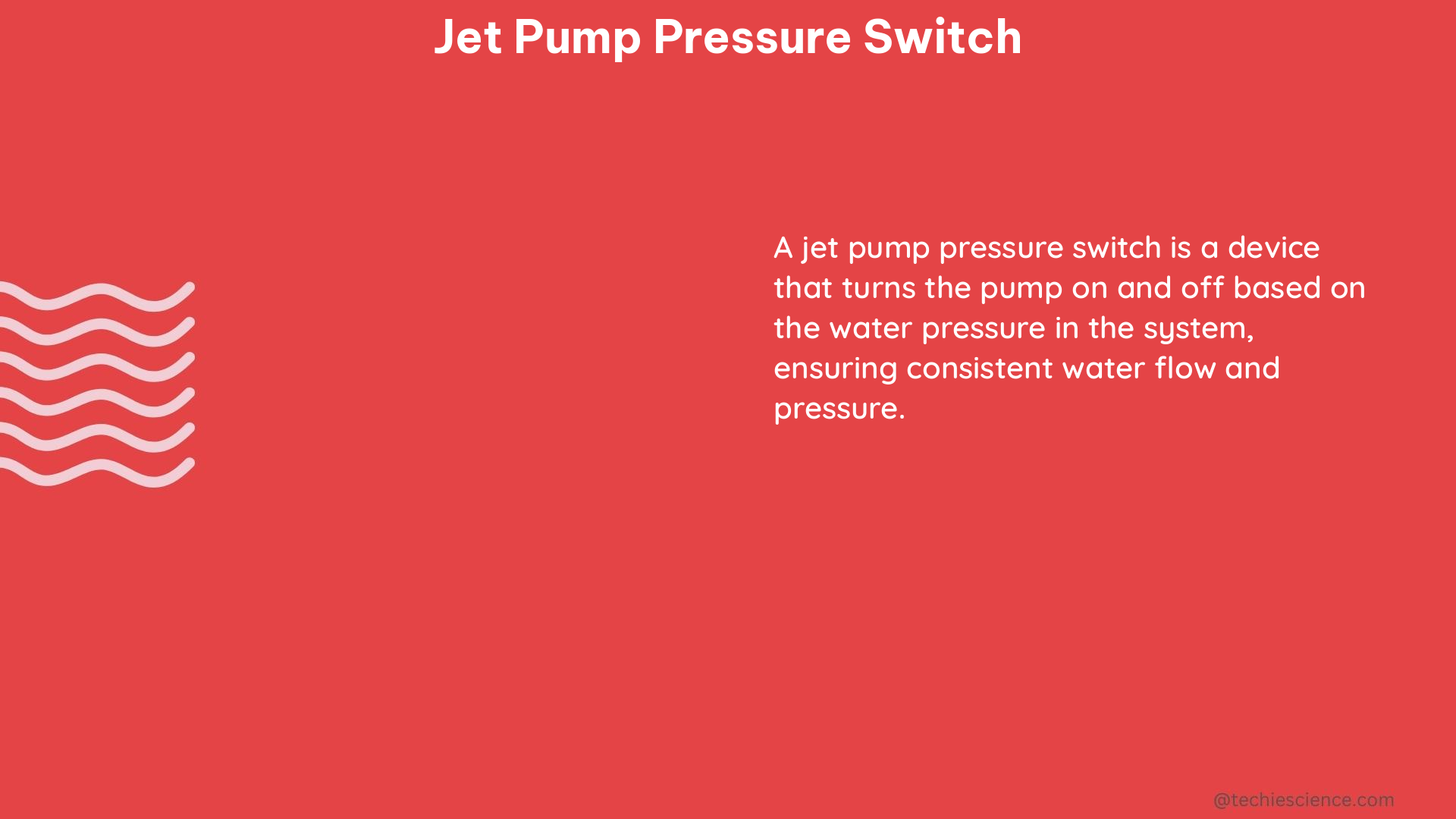A jet pump pressure switch is a critical component in a water well system that controls the operation of the jet pump. It turns the pump on when the pressure in the system drops below a certain level and turns it off when the pressure reaches a higher set point. The pressure switch’s settings and performance significantly impact the system’s efficiency and longevity.
Understanding Pressure Settings
The pressure switch has two adjustable pressure settings: cut-in (lower) and cut-out (higher) pressures. These are typically set to 30/50 psi, 40/60 psi, or 50/70 psi, depending on the specific requirements of the well system. The cut-in pressure is the point at which the pump turns on, and the cut-out pressure is the point at which the pump turns off.
The pressure differential, which is the difference between the cut-in and cut-out pressures, is typically set to 20 psi. This differential ensures that the pump runs long enough to fill the pressure tank and maintain adequate system pressure. A smaller differential, such as 10 psi, may cause the pump to cycle more frequently, leading to increased wear and tear. Conversely, a larger differential, such as 30 psi, may result in the pump running for too long, causing the pressure tank to become over-pressurized.
Measuring Flow Rate and Drawdown

The flow rate is the volume of water that the pump can deliver per unit of time, typically measured in gallons per minute (GPM). The flow rate depends on several factors, including the pump’s size, the well’s yield, and the system’s pressure settings. A higher flow rate can provide more water, but it may also result in a higher power consumption and a shorter recovery time.
Drawdown is the amount of water that the pressure tank can store before the pump needs to turn on. It is measured in gallons and is an essential factor in determining the pump’s sizing and the pressure switch’s settings. A larger drawdown can provide more water during periods of high demand, but it may also result in a longer recovery time.
Optimizing Recovery Time and Cycle Rate
Recovery time is the time it takes for the pump to refill the pressure tank after the pressure has dropped to the cut-in pressure. It is measured in seconds and is an essential factor in determining the pump’s sizing and the pressure switch’s settings. A longer recovery time may indicate that the pump is undersized or that the pressure switch’s settings are not optimized.
Cycle rate is the number of times the pump turns on and off per unit of time, typically measured in cycles per hour. A high cycle rate can indicate that the pressure switch’s settings are not optimized, leading to increased wear and tear on the pump and the pressure switch. Ideally, the cycle rate should be kept within a range of 10-20 cycles per hour to ensure the system’s longevity.
Monitoring Power Consumption
Power consumption is the amount of electrical power that the pump and pressure switch consume during operation, typically measured in watts or kilowatts. A higher power consumption can result in higher operating costs and may indicate that the system is not operating at its optimal efficiency. Monitoring power consumption can help identify issues with the pump or the pressure switch and guide decisions on system upgrades or replacements.
Troubleshooting Pressure Switch Issues
If a new jet pump is causing pressure switch problems, there are several potential causes to consider:
-
Incorrect Pressure Switch Settings: Ensure that the cut-in and cut-out pressures are set correctly for your well system. If the settings are too low or too high, it can cause the pressure switch to malfunction.
-
Incompatible Pressure Switch: Verify that the pressure switch is compatible with the jet pump and the well system. Using an incompatible pressure switch can lead to issues with the pump’s operation.
-
Pressure Tank Issues: Problems with the pressure tank, such as a waterlogged or damaged tank, can affect the pressure switch’s performance and cause it to malfunction.
-
Pump Sizing: If the jet pump is oversized or undersized for the well system, it can lead to pressure switch issues. Ensure that the pump is properly sized for the system’s flow rate and pressure requirements.
-
Electrical Issues: Problems with the electrical wiring or connections can also cause pressure switch malfunctions. Check for any loose or damaged wiring and ensure that the electrical system is properly grounded.
-
Mechanical Wear and Tear: Over time, the pressure switch’s internal components can wear out, leading to malfunctions. Consider replacing the pressure switch if it’s been in use for an extended period.
By understanding the various factors that can affect jet pump pressure switch performance, you can troubleshoot and resolve issues more effectively, ensuring the optimal operation and longevity of your water well system.
Reference:
- How to Determine Your Well Pump Flow Rate on Wells with Pressure Tanks
- Low pressure switch vs pressure switch for well – DoItYourself.com
- Understanding Pressure Switches and Their Functionality
- What’s the real reason for 20 psi differential for water well pressure switch settings?
- How can a New Jet Pump Cause Pressure Switch Problems?

The lambdageeks.com Core SME Team is a group of experienced subject matter experts from diverse scientific and technical fields including Physics, Chemistry, Technology,Electronics & Electrical Engineering, Automotive, Mechanical Engineering. Our team collaborates to create high-quality, well-researched articles on a wide range of science and technology topics for the lambdageeks.com website.
All Our Senior SME are having more than 7 Years of experience in the respective fields . They are either Working Industry Professionals or assocaited With different Universities. Refer Our Authors Page to get to know About our Core SMEs.